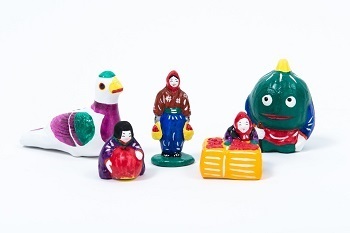ホーム > 組織でさがす > 経済産業部 > 地域企業支援課 > 青森県の伝統工芸品(下川原焼土人形)
関連分野
更新日付:2025年4月1日 地域企業支援課
青森県の伝統工芸品(下川原焼土人形)
下川原焼土人形 (したかわらやきつちにんぎょう) "Shitakawara" Pottery's Earthenware Dolls

下川原焼土人形は江戸時代の後半に九州筑前で陶磁器作りを習得してきた初代高谷金蔵が、津軽藩に召し抱えられて下川原に窯を築いたのが始まりである。
明治時代の土人形人気による隆盛、ブリキなど新しい玩具の普及に押された大正時代の衰退という浮き沈みを経て、現在まで受け継がれている。
下川原焼土人形は赤土と砂を調合した粘土を石膏の型枠にはめて形を整え、約800度の高温で数時間窯焼きし、最後に色つけをして出来上がる。
鳩笛や干支人形が有名であるが、実際人形の種類は数百も存在する。その素朴な形と穏やかな表情によって淡い郷愁がかきたてられる。
“Shitakawara” Pottery's Earthenware Dolls - Simple but warm pigeon whistles that produce a pleasing tone
These dolls first appeared during the latter half of the Edo Period (1603-1867) in the Chikuzen Region of Kyushu, where Kinzo Takaya learned the art of ceramic making. He was then employed by the Tsugaru clan, who built a kiln for him at Shitakawara.
These dolls enjoyed popularity during the Meiji period (1867-1911), but with the increase of toys made from newer materials like tin, their popularity declined during the Taisho period (1911-1925). Despite these periods of ups and downs, they are still being made to this day.
Red earth and sand are mixed together to form clay, which is put into a plaster to shape the doll. It is then fired at a temperature of about 800 degrees for several hours, and then painted to create the finished design.
The pigeon whistles and zodiac figurines are the most well-known, however, there are several hundred varieties of these dolls. They have a somewhat nostalgic quality due to their simple form and tranquil expression.
【県の指定年月】 平成8年3月
【主な製品】 土人形・鳩笛・人形笛
【主な製造工程】 粘土の調合→型ぬき→乾燥→素焼き→地塗り→彩色→完成
【主な製品】 土人形・鳩笛・人形笛
【主な製造工程】 粘土の調合→型ぬき→乾燥→素焼き→地塗り→彩色→完成
| 高谷下川原焼土人形製陶所 | 036-8227 青森県弘前市桔梗野1-20-8 0172-32-6888 |
| 阿保正志 | 036-8083 青森県弘前市新里字上樋田85-2 0172-27-3766 |



